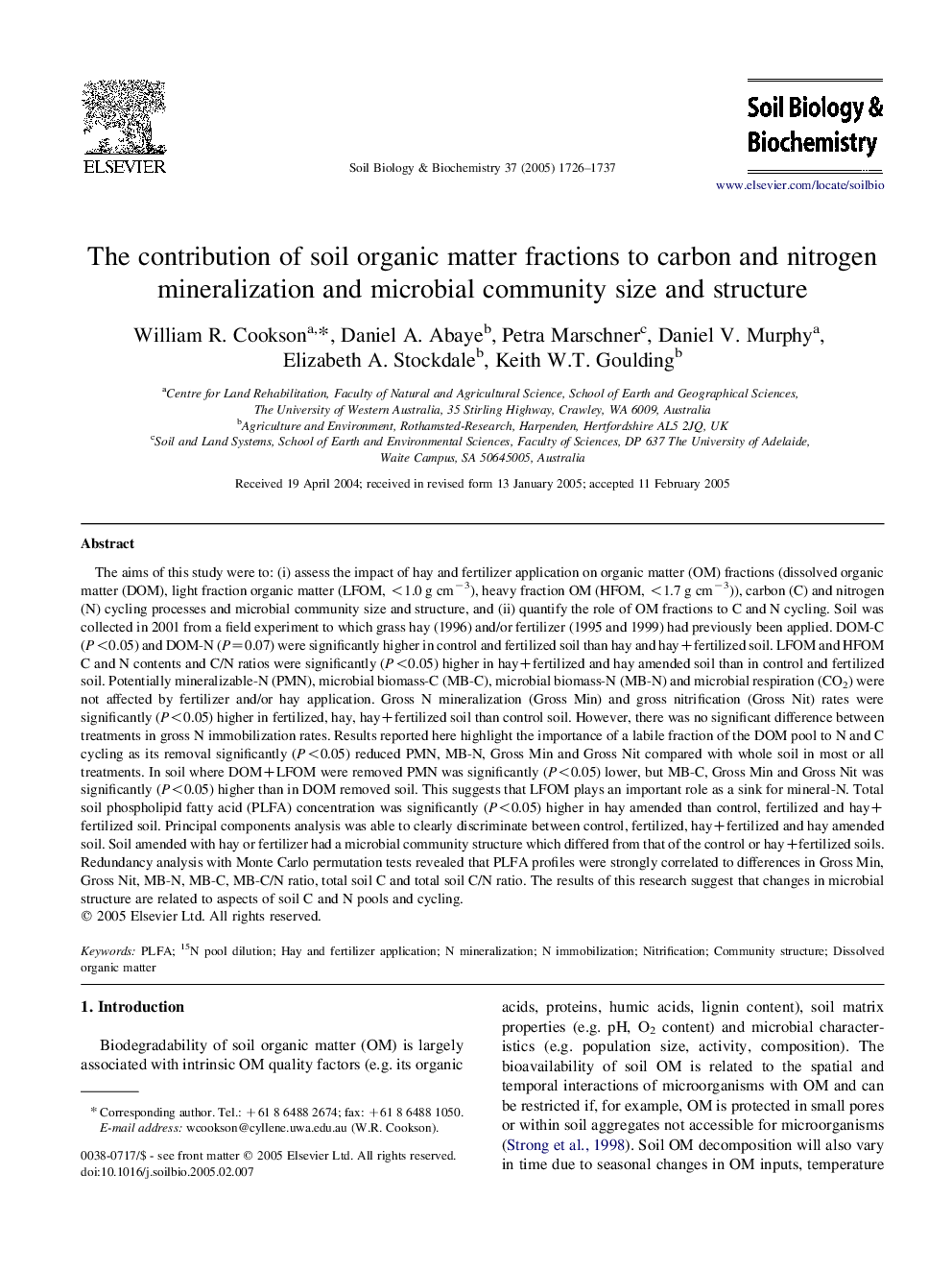| کد مقاله | کد نشریه | سال انتشار | مقاله انگلیسی | نسخه تمام متن |
|---|---|---|---|---|
| 10846180 | 1070040 | 2005 | 12 صفحه PDF | دانلود رایگان |
عنوان انگلیسی مقاله ISI
The contribution of soil organic matter fractions to carbon and nitrogen mineralization and microbial community size and structure
دانلود مقاله + سفارش ترجمه
دانلود مقاله ISI انگلیسی
رایگان برای ایرانیان
کلمات کلیدی
موضوعات مرتبط
علوم زیستی و بیوفناوری
علوم کشاورزی و بیولوژیک
دانش خاک شناسی
پیش نمایش صفحه اول مقاله

چکیده انگلیسی
The aims of this study were to: (i) assess the impact of hay and fertilizer application on organic matter (OM) fractions (dissolved organic matter (DOM), light fraction organic matter (LFOM, <1.0 g cmâ3), heavy fraction OM (HFOM, <1.7 g cmâ3)), carbon (C) and nitrogen (N) cycling processes and microbial community size and structure, and (ii) quantify the role of OM fractions to C and N cycling. Soil was collected in 2001 from a field experiment to which grass hay (1996) and/or fertilizer (1995 and 1999) had previously been applied. DOM-C (P<0.05) and DOM-N (P=0.07) were significantly higher in control and fertilized soil than hay and hay+fertilized soil. LFOM and HFOM C and N contents and C/N ratios were significantly (P<0.05) higher in hay+fertilized and hay amended soil than in control and fertilized soil. Potentially mineralizable-N (PMN), microbial biomass-C (MB-C), microbial biomass-N (MB-N) and microbial respiration (CO2) were not affected by fertilizer and/or hay application. Gross N mineralization (Gross Min) and gross nitrification (Gross Nit) rates were significantly (P<0.05) higher in fertilized, hay, hay+fertilized soil than control soil. However, there was no significant difference between treatments in gross N immobilization rates. Results reported here highlight the importance of a labile fraction of the DOM pool to N and C cycling as its removal significantly (P<0.05) reduced PMN, MB-N, Gross Min and Gross Nit compared with whole soil in most or all treatments. In soil where DOM+LFOM were removed PMN was significantly (P<0.05) lower, but MB-C, Gross Min and Gross Nit was significantly (P<0.05) higher than in DOM removed soil. This suggests that LFOM plays an important role as a sink for mineral-N. Total soil phospholipid fatty acid (PLFA) concentration was significantly (P<0.05) higher in hay amended than control, fertilized and hay+fertilized soil. Principal components analysis was able to clearly discriminate between control, fertilized, hay+fertilized and hay amended soil. Soil amended with hay or fertilizer had a microbial community structure which differed from that of the control or hay+fertilized soils. Redundancy analysis with Monte Carlo permutation tests revealed that PLFA profiles were strongly correlated to differences in Gross Min, Gross Nit, MB-N, MB-C, MB-C/N ratio, total soil C and total soil C/N ratio. The results of this research suggest that changes in microbial structure are related to aspects of soil C and N pools and cycling.
ناشر
Database: Elsevier - ScienceDirect (ساینس دایرکت)
Journal: Soil Biology and Biochemistry - Volume 37, Issue 9, September 2005, Pages 1726-1737
Journal: Soil Biology and Biochemistry - Volume 37, Issue 9, September 2005, Pages 1726-1737
نویسندگان
William R. Cookson, Daniel A. Abaye, Petra Marschner, Daniel V. Murphy, Elizabeth A. Stockdale, Keith W.T. Goulding,